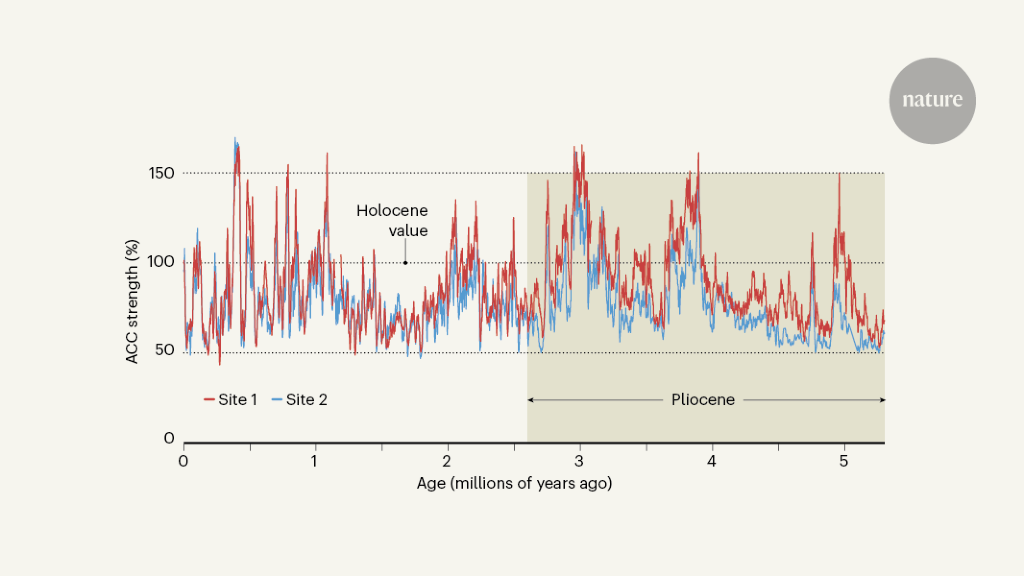Unveiling the Southern Ocean's Circumpolar Current
Core Concepts
The Southern Ocean's Antarctic circumpolar current plays a crucial role in global ocean circulation and climate regulation, with its history revealing surprising stability amidst changing environmental conditions.
Abstract
The Southern Ocean harbors the Antarctic circumpolar current (ACC), a powerful force that propels over 100 million cubic meters of water per second around the globe. This current, connecting the Pacific, Indian, and Atlantic ocean basins, is pivotal in the global ocean circulation and climate regulation. Lamy et al. present reconstructions in Nature showcasing the ACC's variability over millennia due to Earth's orbit changes. Despite long-term temperature shifts, the current's strength has remained relatively stable for five million years, hinting at evolving impacts of global cooling and potential insights into future warming effects on this influential current.
The Southern Ocean hosts the Antarctic circumpolar current (ACC), a significant player in global ocean circulation.
Lamy et al. present reconstructions revealing the ACC's variability over millennia due to Earth's orbit changes.
Despite long-term temperature shifts, the ACC's strength has remained stable for five million years, indicating evolving impacts of global cooling.
The surprising history of the Southern Ocean’s super current
Stats
The Antarctic circumpolar current transports over 100 million cubic meters of water per second.
The ACC's strength has remained relatively stable over the past five million years.
Quotes
"Connecting the Pacific, Indian, and Atlantic ocean basins, the Antarctic circumpolar current plays a central role in global ocean circulation and climate regulation."
"The records indicate that the current’s strength has remained relatively stable over the past five million years, despite long-term changes in Earth’s temperature."
Key Insights Distilled From
by Natalie J. B... at www.nature.com 03-27-2024
https://www.nature.com/articles/d41586-024-00678-5
Deeper Inquiries
How does the stability of the Antarctic circumpolar current over five million years contrast with other ocean currents?
The stability of the Antarctic circumpolar current (ACC) over the past five million years contrasts with other ocean currents in terms of its resilience to long-term changes in Earth's temperature. While the ACC has remained relatively stable despite fluctuations in global temperatures, many other ocean currents have shown more variability in response to climate changes. This unique characteristic of the ACC highlights its robustness and suggests that it may have distinct mechanisms governing its behavior compared to other currents.
What potential implications could the evolving impacts of global cooling on the ACC have for future climate scenarios?
The evolving impacts of global cooling on the Antarctic circumpolar current (ACC) could have significant implications for future climate scenarios. As the ACC has shown pronounced variability on the timescale of multiple millennia due to changes in Earth's orbit, understanding how these changes affect the current's strength can provide insights into how future warming will impact it. This knowledge is crucial for predicting how the ACC will respond to ongoing climate change and how it may influence global ocean circulation patterns and climate regulation in the future.
How might understanding the history of the Southern Ocean's super current inform strategies for climate change mitigation?
Understanding the history of the Southern Ocean's super current, particularly the Antarctic circumpolar current (ACC), can inform strategies for climate change mitigation by shedding light on the current's response to past climate variations. By studying the ACC's behavior over the past five million years and how it has adapted to changes in Earth's temperature, scientists can gain valuable insights into how the current may respond to future climate scenarios. This knowledge can help in developing more accurate climate models, predicting the impact of climate change on the ACC, and implementing targeted mitigation strategies to preserve the stability and functionality of this influential current in the face of ongoing global warming.
0
